Audit Planning and Financial Analysis: Morris Ltd Case Study
VerifiedAdded on 2022/08/24
|16
|1770
|14
Case Study
AI Summary
This case study focuses on the financial analysis and audit planning for Morris Ltd, a company recently listed on the Australian Securities Exchange. The assignment requires an analysis of the company's financial statements, including the application of analytical procedures to identify and assess material misstatement risks. It emphasizes the importance of professional skepticism throughout the audit process and the determination of materiality. The case study includes ratio analysis, comparing key financial figures from 2018 and 2019 to evaluate profitability, liquidity, and solvency. The student analyzes the financial ratios, identifying trends and potential risks such as declining gross profit margins, negative net profit margins, and changes in liquidity ratios. The analysis concludes with an assessment of potential material misstatements in the financial statements, specifically highlighting risks related to total liabilities, cost of sales, and inventory valuation.
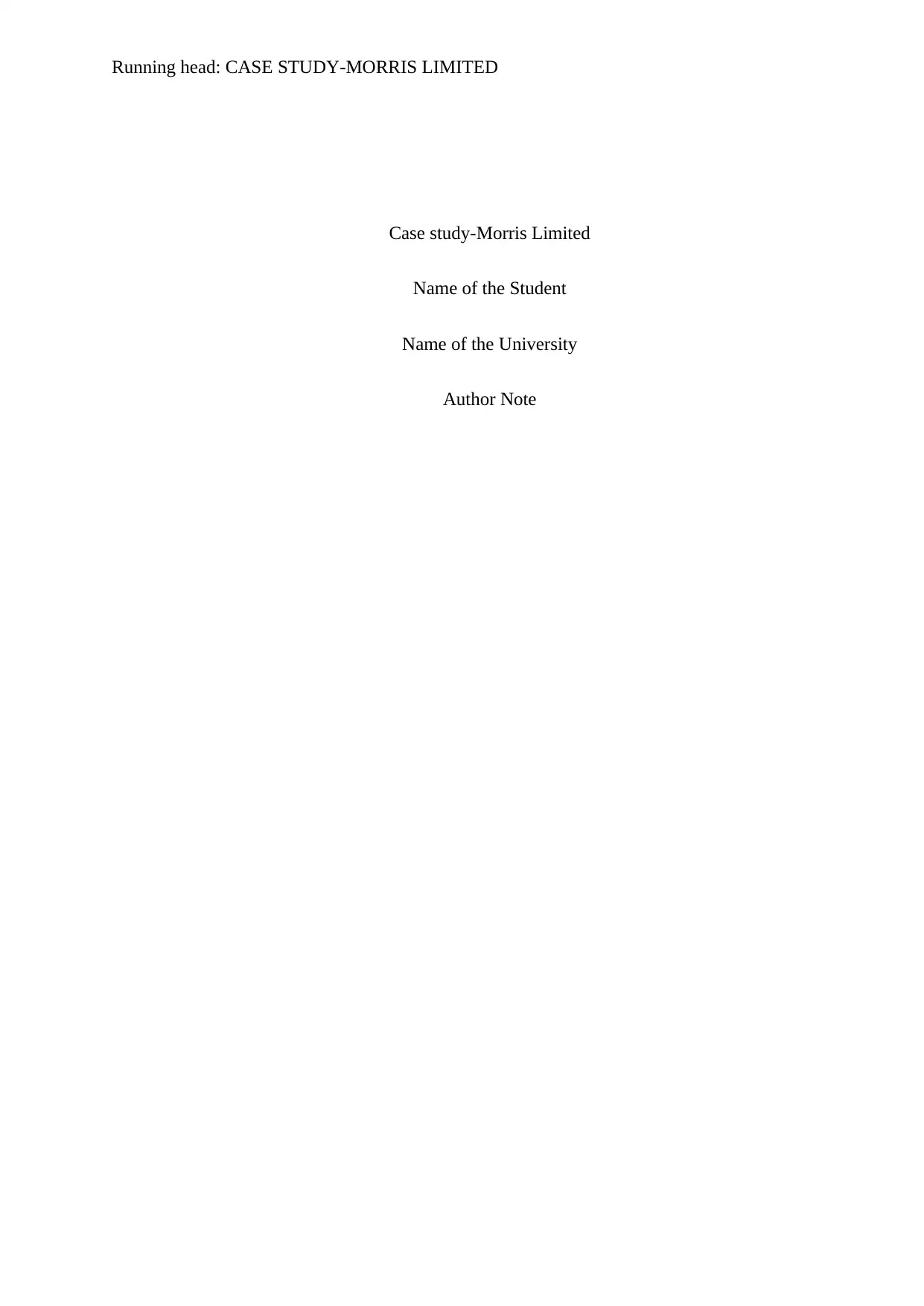
Running head: CASE STUDY-MORRIS LIMITED
Case study-Morris Limited
Name of the Student
Name of the University
Author Note
Case study-Morris Limited
Name of the Student
Name of the University
Author Note
Paraphrase This Document
Need a fresh take? Get an instant paraphrase of this document with our AI Paraphraser
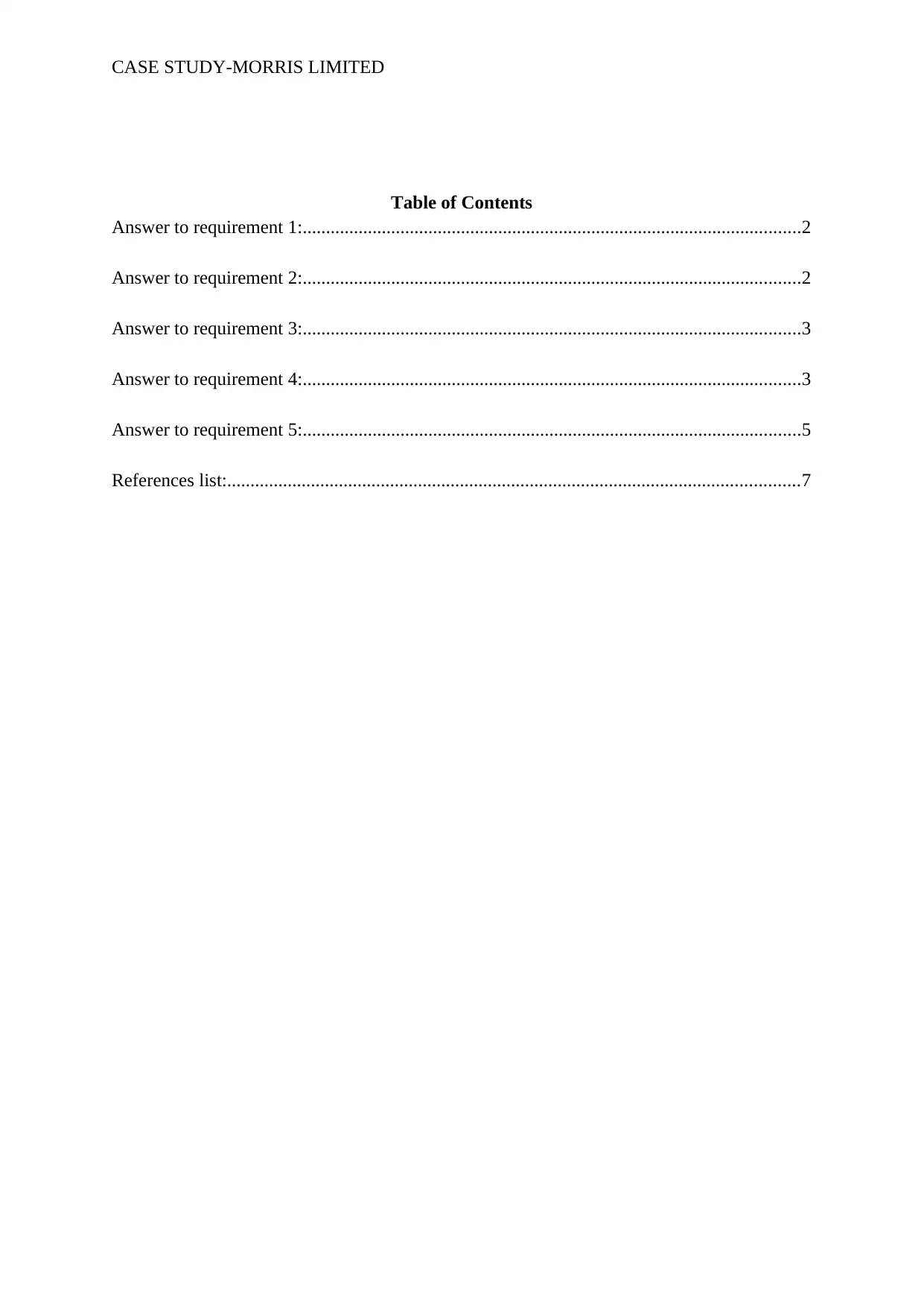
CASE STUDY-MORRIS LIMITED
Table of Contents
Answer to requirement 1:...........................................................................................................2
Answer to requirement 2:...........................................................................................................2
Answer to requirement 3:...........................................................................................................3
Answer to requirement 4:...........................................................................................................3
Answer to requirement 5:...........................................................................................................5
References list:...........................................................................................................................7
Table of Contents
Answer to requirement 1:...........................................................................................................2
Answer to requirement 2:...........................................................................................................2
Answer to requirement 3:...........................................................................................................3
Answer to requirement 4:...........................................................................................................3
Answer to requirement 5:...........................................................................................................5
References list:...........................................................................................................................7
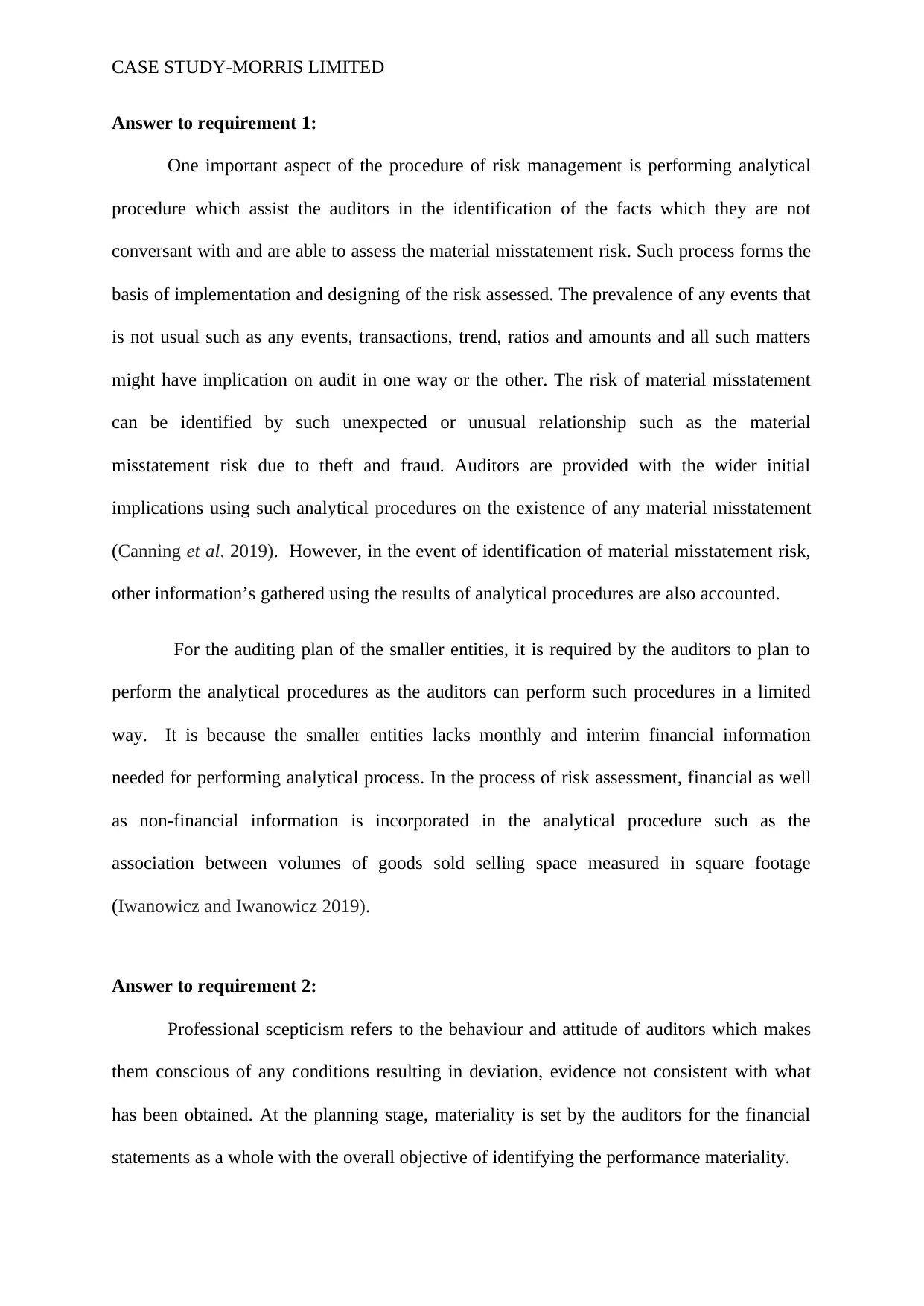
CASE STUDY-MORRIS LIMITED
Answer to requirement 1:
One important aspect of the procedure of risk management is performing analytical
procedure which assist the auditors in the identification of the facts which they are not
conversant with and are able to assess the material misstatement risk. Such process forms the
basis of implementation and designing of the risk assessed. The prevalence of any events that
is not usual such as any events, transactions, trend, ratios and amounts and all such matters
might have implication on audit in one way or the other. The risk of material misstatement
can be identified by such unexpected or unusual relationship such as the material
misstatement risk due to theft and fraud. Auditors are provided with the wider initial
implications using such analytical procedures on the existence of any material misstatement
(Canning et al. 2019). However, in the event of identification of material misstatement risk,
other information’s gathered using the results of analytical procedures are also accounted.
For the auditing plan of the smaller entities, it is required by the auditors to plan to
perform the analytical procedures as the auditors can perform such procedures in a limited
way. It is because the smaller entities lacks monthly and interim financial information
needed for performing analytical process. In the process of risk assessment, financial as well
as non-financial information is incorporated in the analytical procedure such as the
association between volumes of goods sold selling space measured in square footage
(Iwanowicz and Iwanowicz 2019).
Answer to requirement 2:
Professional scepticism refers to the behaviour and attitude of auditors which makes
them conscious of any conditions resulting in deviation, evidence not consistent with what
has been obtained. At the planning stage, materiality is set by the auditors for the financial
statements as a whole with the overall objective of identifying the performance materiality.
Answer to requirement 1:
One important aspect of the procedure of risk management is performing analytical
procedure which assist the auditors in the identification of the facts which they are not
conversant with and are able to assess the material misstatement risk. Such process forms the
basis of implementation and designing of the risk assessed. The prevalence of any events that
is not usual such as any events, transactions, trend, ratios and amounts and all such matters
might have implication on audit in one way or the other. The risk of material misstatement
can be identified by such unexpected or unusual relationship such as the material
misstatement risk due to theft and fraud. Auditors are provided with the wider initial
implications using such analytical procedures on the existence of any material misstatement
(Canning et al. 2019). However, in the event of identification of material misstatement risk,
other information’s gathered using the results of analytical procedures are also accounted.
For the auditing plan of the smaller entities, it is required by the auditors to plan to
perform the analytical procedures as the auditors can perform such procedures in a limited
way. It is because the smaller entities lacks monthly and interim financial information
needed for performing analytical process. In the process of risk assessment, financial as well
as non-financial information is incorporated in the analytical procedure such as the
association between volumes of goods sold selling space measured in square footage
(Iwanowicz and Iwanowicz 2019).
Answer to requirement 2:
Professional scepticism refers to the behaviour and attitude of auditors which makes
them conscious of any conditions resulting in deviation, evidence not consistent with what
has been obtained. At the planning stage, materiality is set by the auditors for the financial
statements as a whole with the overall objective of identifying the performance materiality.
⊘ This is a preview!⊘
Do you want full access?
Subscribe today to unlock all pages.

Trusted by 1+ million students worldwide
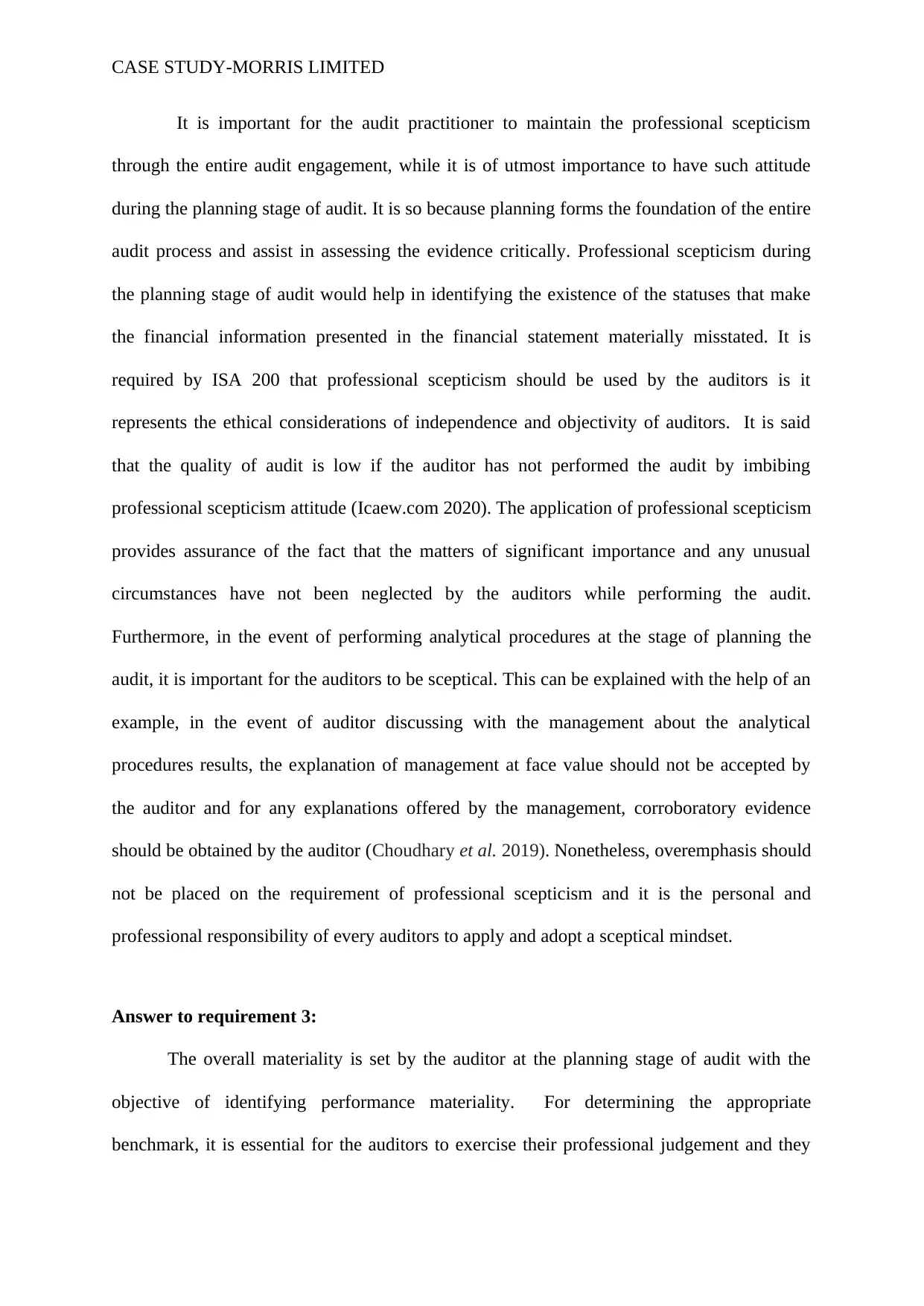
CASE STUDY-MORRIS LIMITED
It is important for the audit practitioner to maintain the professional scepticism
through the entire audit engagement, while it is of utmost importance to have such attitude
during the planning stage of audit. It is so because planning forms the foundation of the entire
audit process and assist in assessing the evidence critically. Professional scepticism during
the planning stage of audit would help in identifying the existence of the statuses that make
the financial information presented in the financial statement materially misstated. It is
required by ISA 200 that professional scepticism should be used by the auditors is it
represents the ethical considerations of independence and objectivity of auditors. It is said
that the quality of audit is low if the auditor has not performed the audit by imbibing
professional scepticism attitude (Icaew.com 2020). The application of professional scepticism
provides assurance of the fact that the matters of significant importance and any unusual
circumstances have not been neglected by the auditors while performing the audit.
Furthermore, in the event of performing analytical procedures at the stage of planning the
audit, it is important for the auditors to be sceptical. This can be explained with the help of an
example, in the event of auditor discussing with the management about the analytical
procedures results, the explanation of management at face value should not be accepted by
the auditor and for any explanations offered by the management, corroboratory evidence
should be obtained by the auditor (Choudhary et al. 2019). Nonetheless, overemphasis should
not be placed on the requirement of professional scepticism and it is the personal and
professional responsibility of every auditors to apply and adopt a sceptical mindset.
Answer to requirement 3:
The overall materiality is set by the auditor at the planning stage of audit with the
objective of identifying performance materiality. For determining the appropriate
benchmark, it is essential for the auditors to exercise their professional judgement and they
It is important for the audit practitioner to maintain the professional scepticism
through the entire audit engagement, while it is of utmost importance to have such attitude
during the planning stage of audit. It is so because planning forms the foundation of the entire
audit process and assist in assessing the evidence critically. Professional scepticism during
the planning stage of audit would help in identifying the existence of the statuses that make
the financial information presented in the financial statement materially misstated. It is
required by ISA 200 that professional scepticism should be used by the auditors is it
represents the ethical considerations of independence and objectivity of auditors. It is said
that the quality of audit is low if the auditor has not performed the audit by imbibing
professional scepticism attitude (Icaew.com 2020). The application of professional scepticism
provides assurance of the fact that the matters of significant importance and any unusual
circumstances have not been neglected by the auditors while performing the audit.
Furthermore, in the event of performing analytical procedures at the stage of planning the
audit, it is important for the auditors to be sceptical. This can be explained with the help of an
example, in the event of auditor discussing with the management about the analytical
procedures results, the explanation of management at face value should not be accepted by
the auditor and for any explanations offered by the management, corroboratory evidence
should be obtained by the auditor (Choudhary et al. 2019). Nonetheless, overemphasis should
not be placed on the requirement of professional scepticism and it is the personal and
professional responsibility of every auditors to apply and adopt a sceptical mindset.
Answer to requirement 3:
The overall materiality is set by the auditor at the planning stage of audit with the
objective of identifying performance materiality. For determining the appropriate
benchmark, it is essential for the auditors to exercise their professional judgement and they
Paraphrase This Document
Need a fresh take? Get an instant paraphrase of this document with our AI Paraphraser
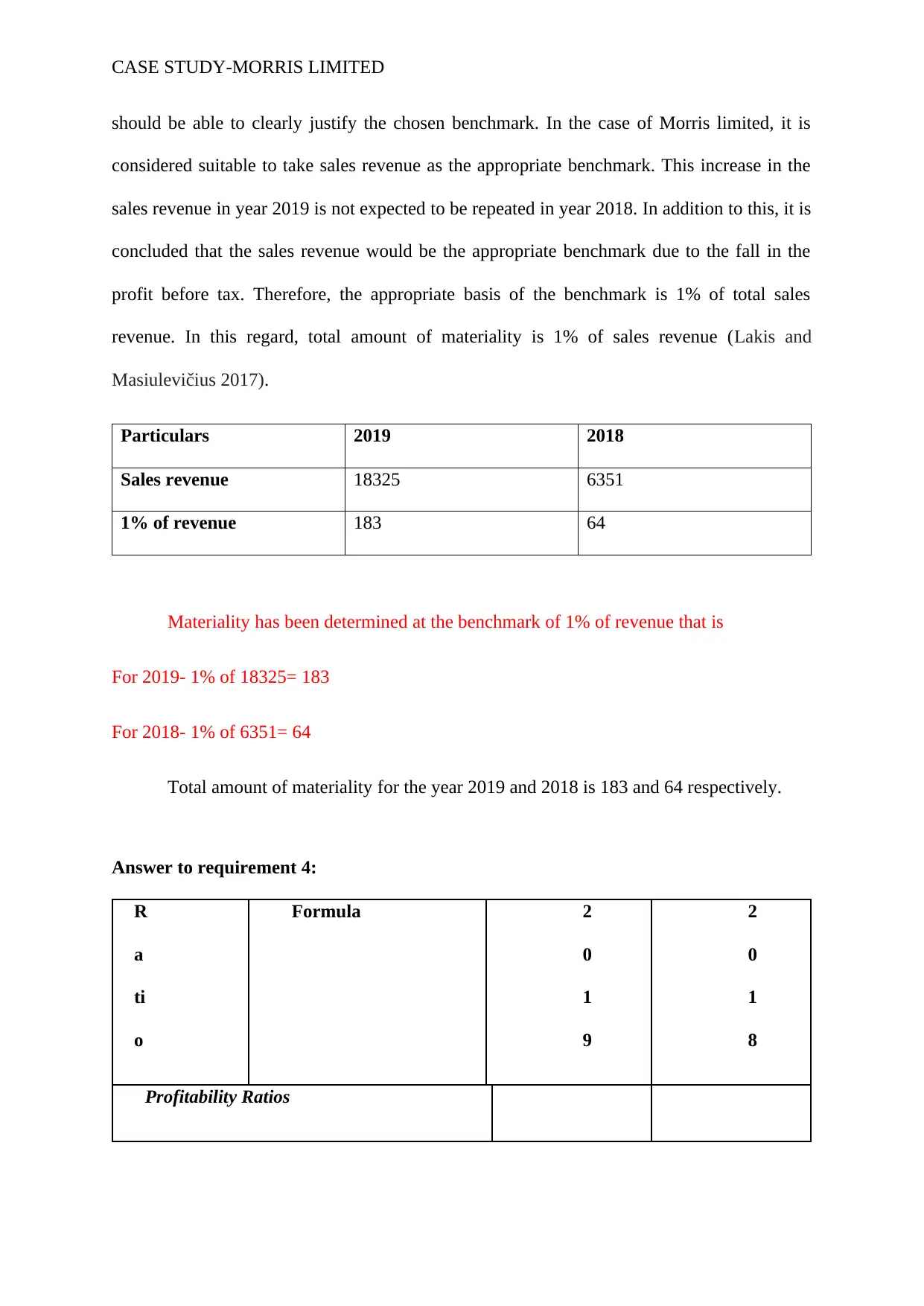
CASE STUDY-MORRIS LIMITED
should be able to clearly justify the chosen benchmark. In the case of Morris limited, it is
considered suitable to take sales revenue as the appropriate benchmark. This increase in the
sales revenue in year 2019 is not expected to be repeated in year 2018. In addition to this, it is
concluded that the sales revenue would be the appropriate benchmark due to the fall in the
profit before tax. Therefore, the appropriate basis of the benchmark is 1% of total sales
revenue. In this regard, total amount of materiality is 1% of sales revenue (Lakis and
Masiulevičius 2017).
Particulars 2019 2018
Sales revenue 18325 6351
1% of revenue 183 64
Materiality has been determined at the benchmark of 1% of revenue that is
For 2019- 1% of 18325= 183
For 2018- 1% of 6351= 64
Total amount of materiality for the year 2019 and 2018 is 183 and 64 respectively.
Answer to requirement 4:
R
a
ti
o
Formula 2
0
1
9
2
0
1
8
Profitability Ratios
should be able to clearly justify the chosen benchmark. In the case of Morris limited, it is
considered suitable to take sales revenue as the appropriate benchmark. This increase in the
sales revenue in year 2019 is not expected to be repeated in year 2018. In addition to this, it is
concluded that the sales revenue would be the appropriate benchmark due to the fall in the
profit before tax. Therefore, the appropriate basis of the benchmark is 1% of total sales
revenue. In this regard, total amount of materiality is 1% of sales revenue (Lakis and
Masiulevičius 2017).
Particulars 2019 2018
Sales revenue 18325 6351
1% of revenue 183 64
Materiality has been determined at the benchmark of 1% of revenue that is
For 2019- 1% of 18325= 183
For 2018- 1% of 6351= 64
Total amount of materiality for the year 2019 and 2018 is 183 and 64 respectively.
Answer to requirement 4:
R
a
ti
o
Formula 2
0
1
9
2
0
1
8
Profitability Ratios
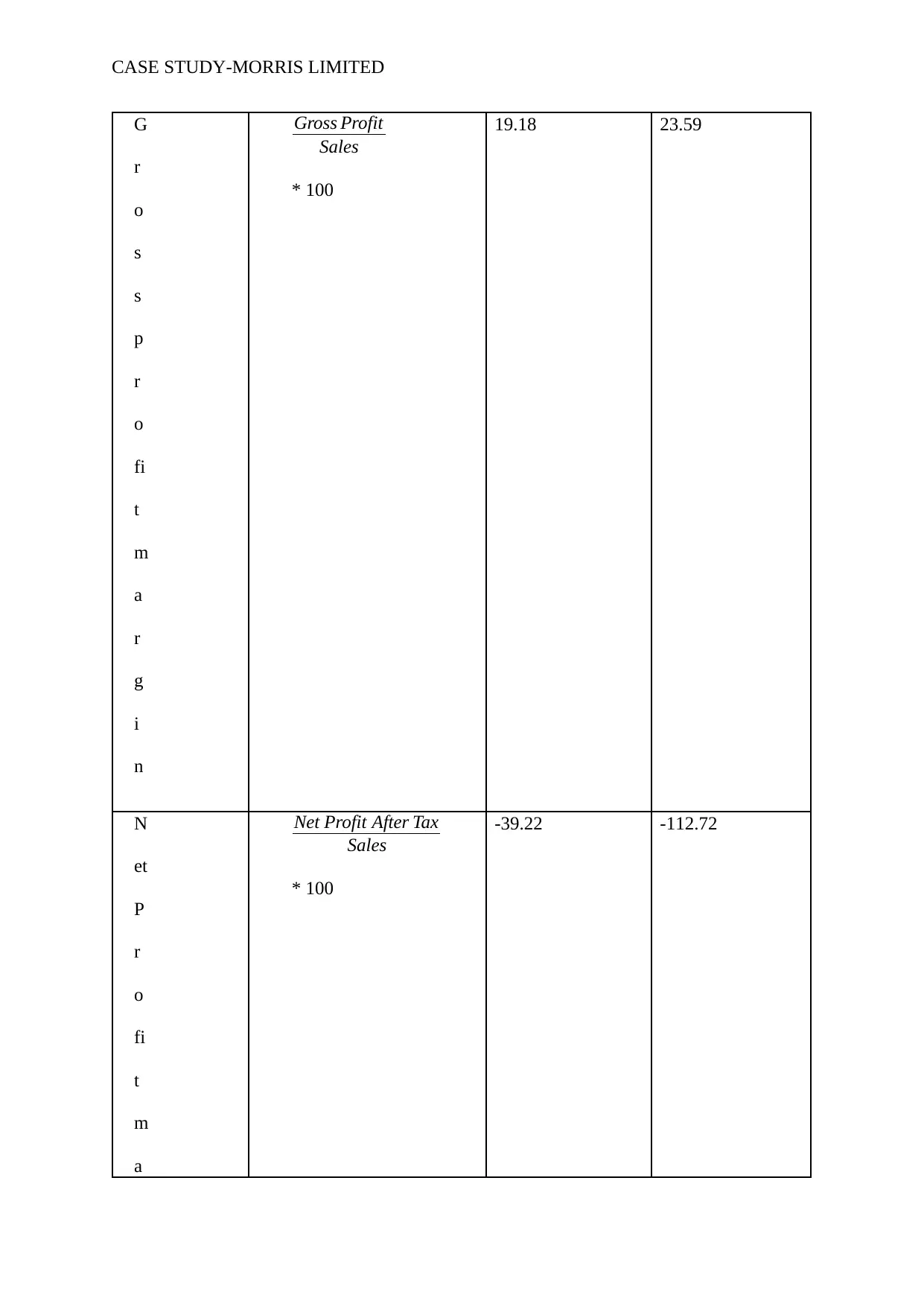
CASE STUDY-MORRIS LIMITED
G
r
o
s
s
p
r
o
fi
t
m
a
r
g
i
n
Gross Profit
Sales
* 100
19.18 23.59
N
et
P
r
o
fi
t
m
a
Net Profit After Tax
Sales
* 100
-39.22 -112.72
G
r
o
s
s
p
r
o
fi
t
m
a
r
g
i
n
Gross Profit
Sales
* 100
19.18 23.59
N
et
P
r
o
fi
t
m
a
Net Profit After Tax
Sales
* 100
-39.22 -112.72
⊘ This is a preview!⊘
Do you want full access?
Subscribe today to unlock all pages.

Trusted by 1+ million students worldwide
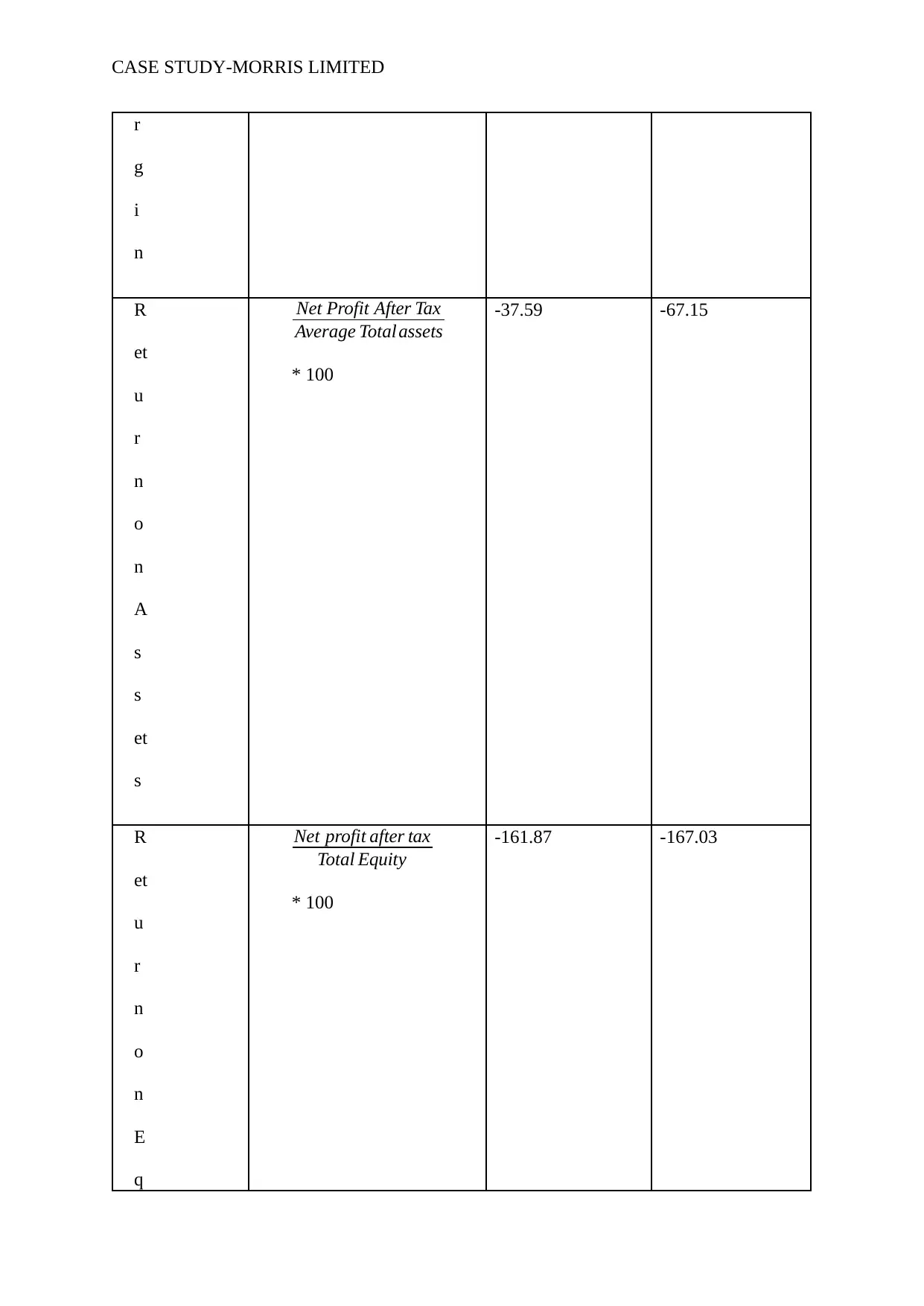
CASE STUDY-MORRIS LIMITED
r
g
i
n
R
et
u
r
n
o
n
A
s
s
et
s
Net Profit After Tax
Average Total assets
* 100
-37.59 -67.15
R
et
u
r
n
o
n
E
q
Net profit after tax
Total Equity
* 100
-161.87 -167.03
r
g
i
n
R
et
u
r
n
o
n
A
s
s
et
s
Net Profit After Tax
Average Total assets
* 100
-37.59 -67.15
R
et
u
r
n
o
n
E
q
Net profit after tax
Total Equity
* 100
-161.87 -167.03
Paraphrase This Document
Need a fresh take? Get an instant paraphrase of this document with our AI Paraphraser
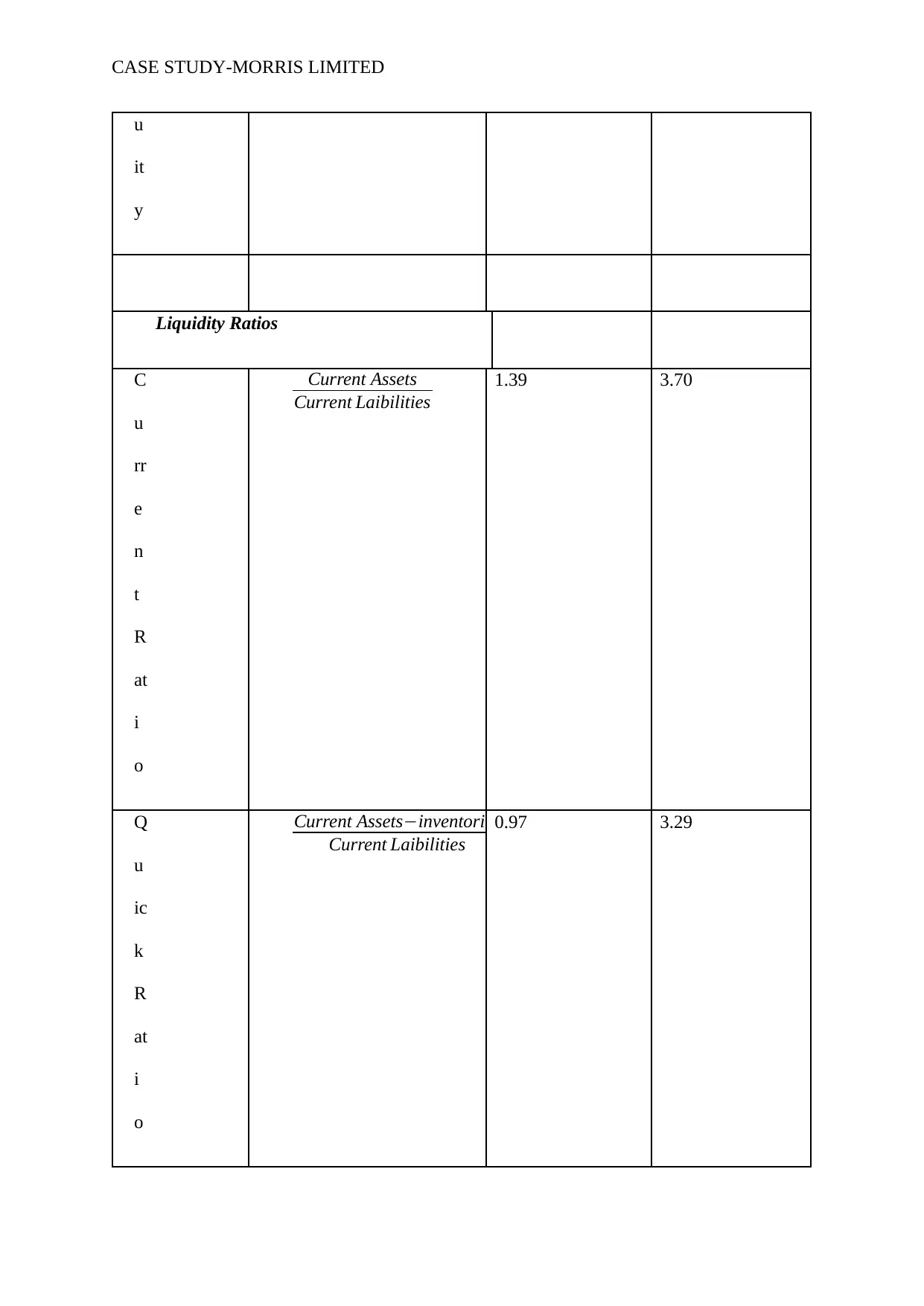
CASE STUDY-MORRIS LIMITED
u
it
y
Liquidity Ratios
C
u
rr
e
n
t
R
at
i
o
Current Assets
Current Laibilities
1.39 3.70
Q
u
ic
k
R
at
i
o
Current Assets−inventories
Current Laibilities
0.97 3.29
u
it
y
Liquidity Ratios
C
u
rr
e
n
t
R
at
i
o
Current Assets
Current Laibilities
1.39 3.70
Q
u
ic
k
R
at
i
o
Current Assets−inventories
Current Laibilities
0.97 3.29
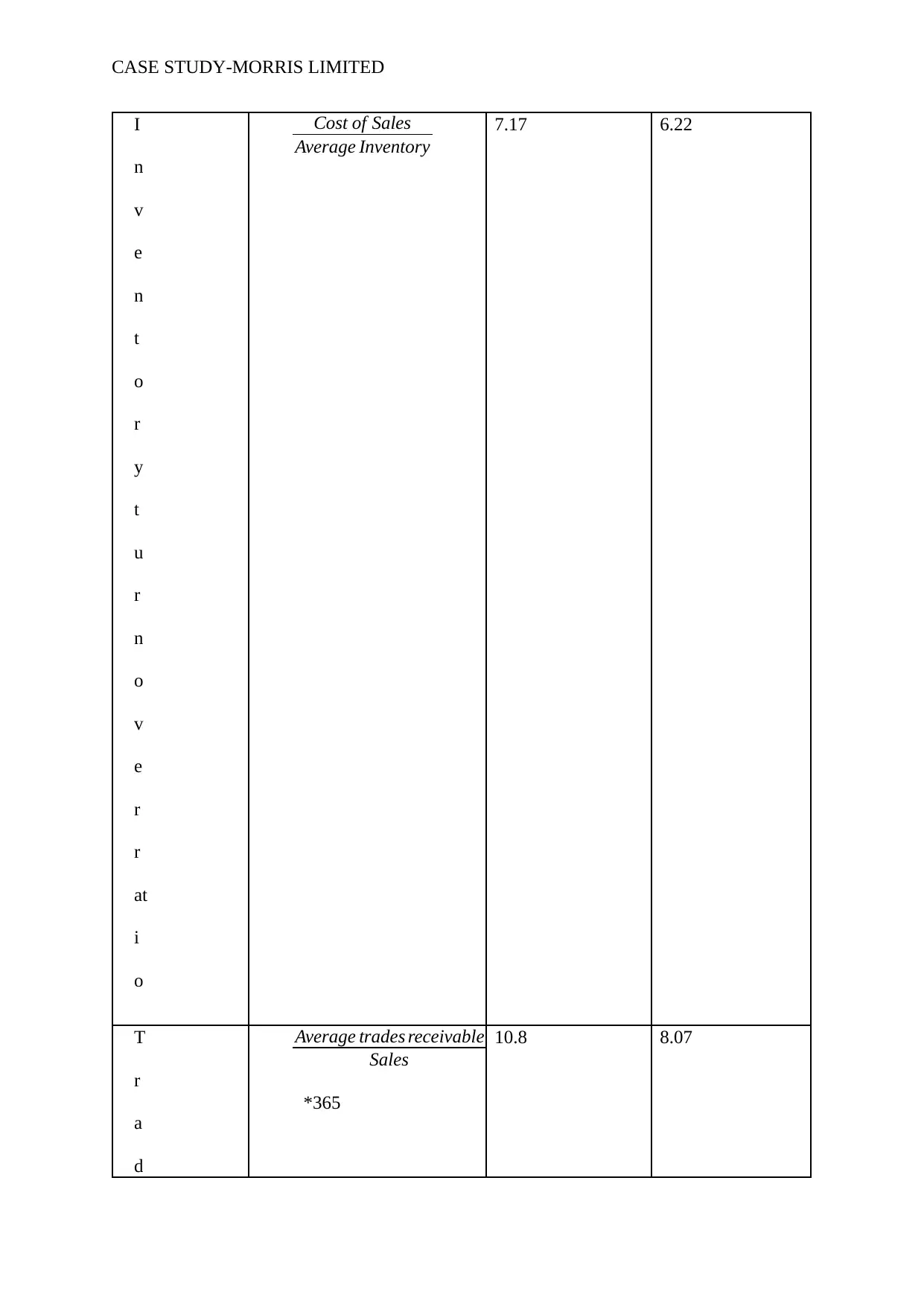
CASE STUDY-MORRIS LIMITED
I
n
v
e
n
t
o
r
y
t
u
r
n
o
v
e
r
r
at
i
o
Cost of Sales
Average Inventory
7.17 6.22
T
r
a
d
Average trades receivable
Sales
*365
10.8 8.07
I
n
v
e
n
t
o
r
y
t
u
r
n
o
v
e
r
r
at
i
o
Cost of Sales
Average Inventory
7.17 6.22
T
r
a
d
Average trades receivable
Sales
*365
10.8 8.07
⊘ This is a preview!⊘
Do you want full access?
Subscribe today to unlock all pages.

Trusted by 1+ million students worldwide
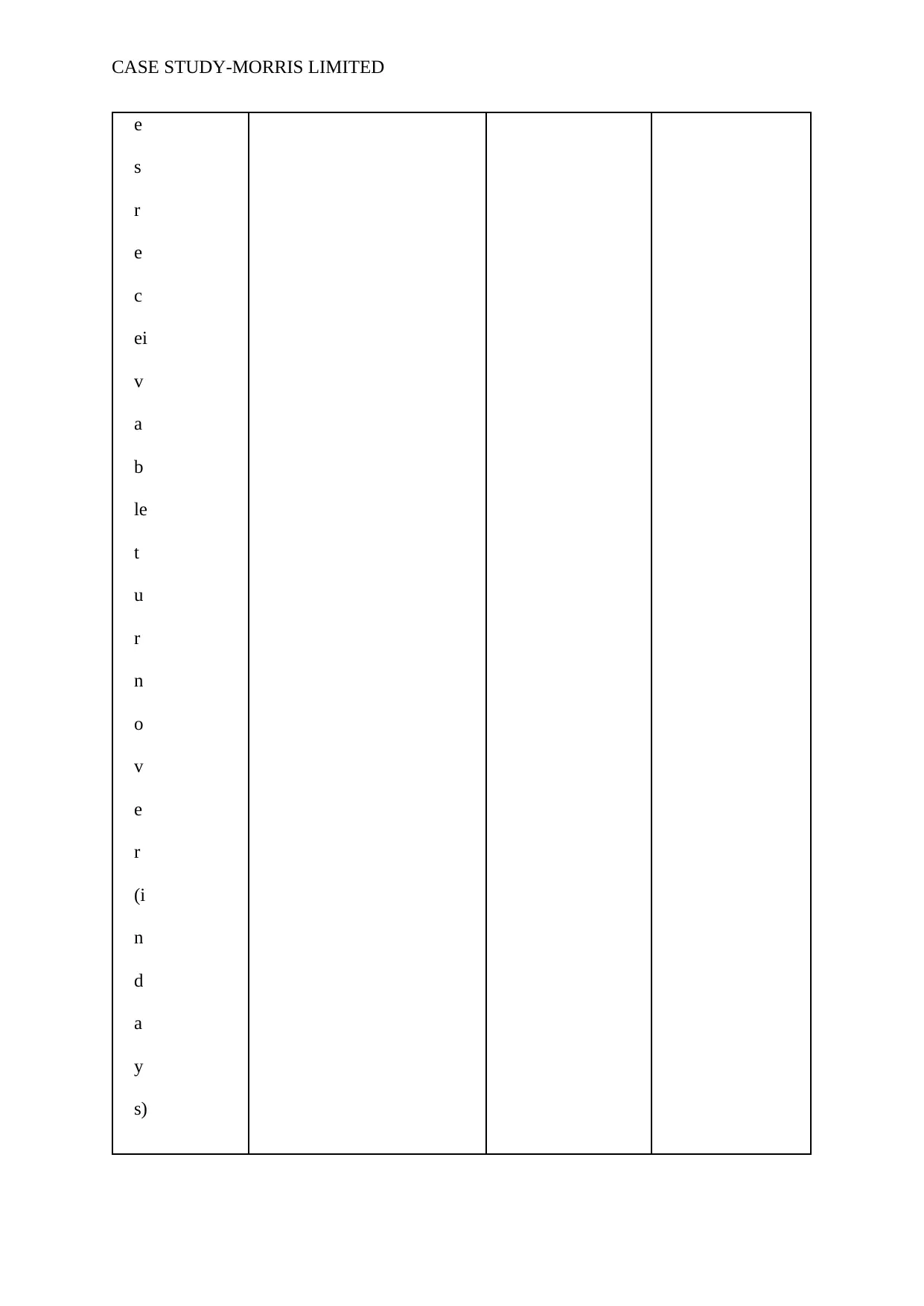
CASE STUDY-MORRIS LIMITED
e
s
r
e
c
ei
v
a
b
le
t
u
r
n
o
v
e
r
(i
n
d
a
y
s)
e
s
r
e
c
ei
v
a
b
le
t
u
r
n
o
v
e
r
(i
n
d
a
y
s)
Paraphrase This Document
Need a fresh take? Get an instant paraphrase of this document with our AI Paraphraser
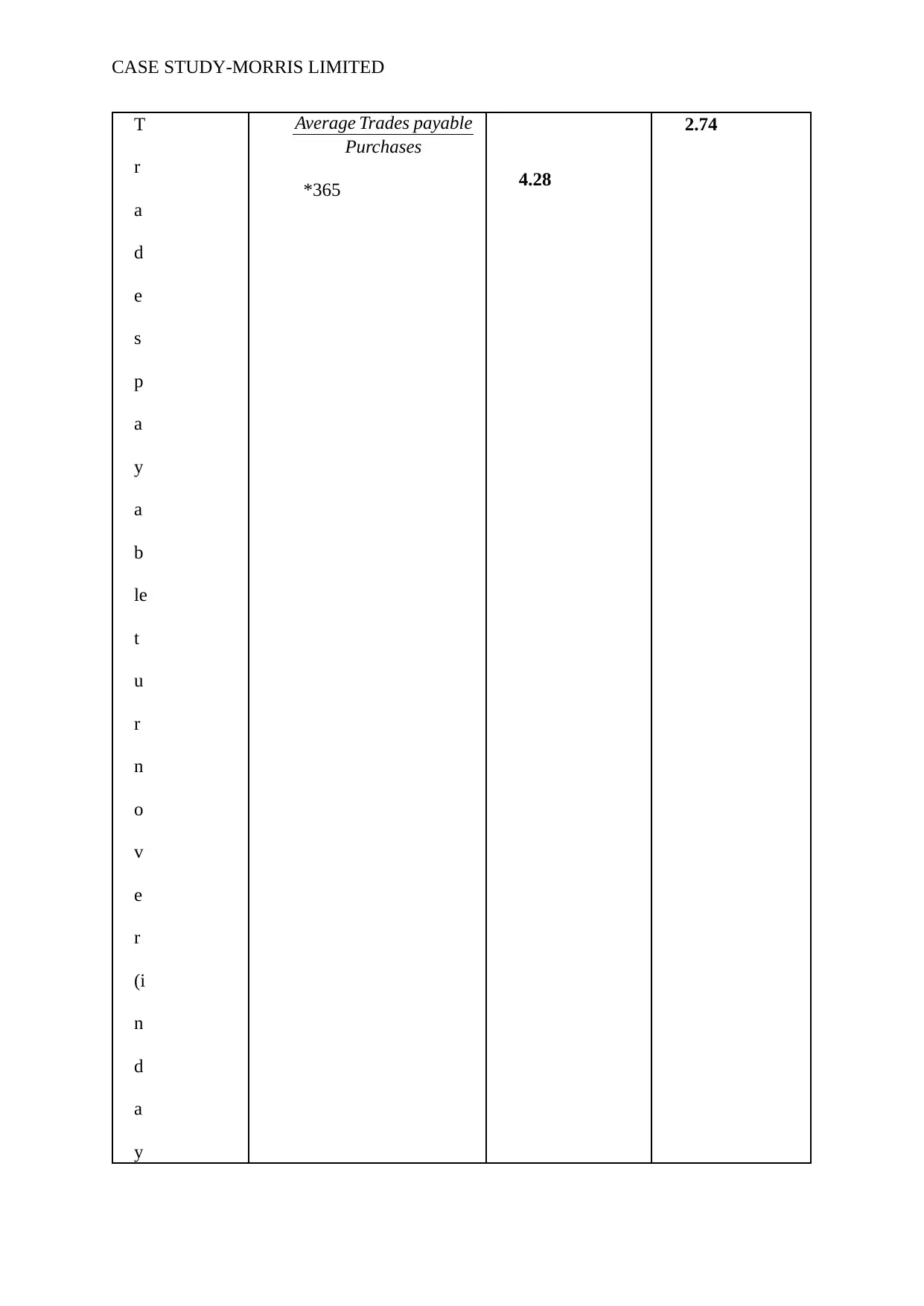
CASE STUDY-MORRIS LIMITED
T
r
a
d
e
s
p
a
y
a
b
le
t
u
r
n
o
v
e
r
(i
n
d
a
y
Average Trades payable
Purchases
*365 4.28
2.74
T
r
a
d
e
s
p
a
y
a
b
le
t
u
r
n
o
v
e
r
(i
n
d
a
y
Average Trades payable
Purchases
*365 4.28
2.74
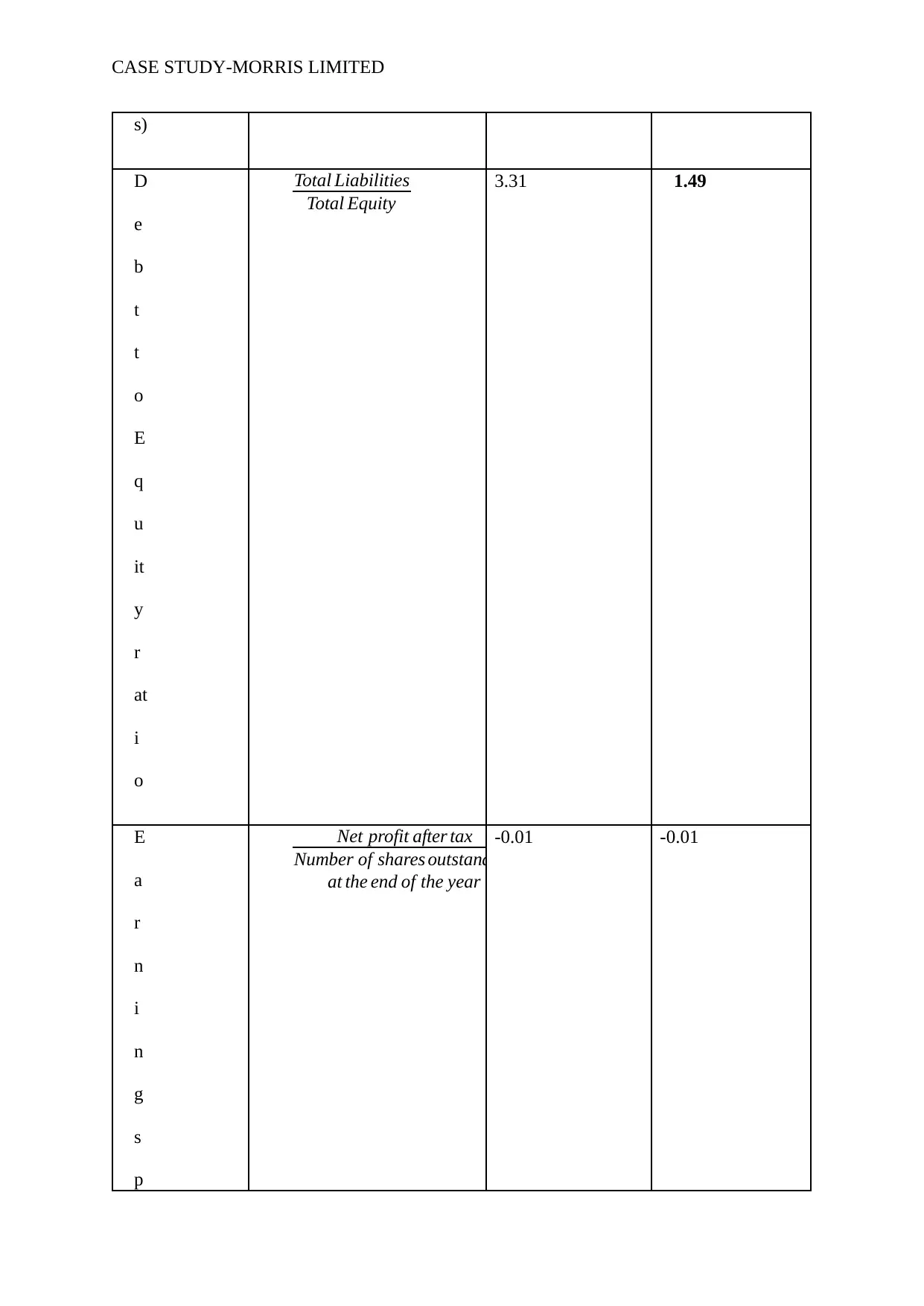
CASE STUDY-MORRIS LIMITED
s)
D
e
b
t
t
o
E
q
u
it
y
r
at
i
o
Total Liabilities
Total Equity
3.31 1.49
E
a
r
n
i
n
g
s
p
Net profit after tax
Number of shares outstanding
at the end of the year
-0.01 -0.01
s)
D
e
b
t
t
o
E
q
u
it
y
r
at
i
o
Total Liabilities
Total Equity
3.31 1.49
E
a
r
n
i
n
g
s
p
Net profit after tax
Number of shares outstanding
at the end of the year
-0.01 -0.01
⊘ This is a preview!⊘
Do you want full access?
Subscribe today to unlock all pages.

Trusted by 1+ million students worldwide
1 out of 16
Related Documents
Your All-in-One AI-Powered Toolkit for Academic Success.
+13062052269
info@desklib.com
Available 24*7 on WhatsApp / Email
![[object Object]](/_next/static/media/star-bottom.7253800d.svg)
Unlock your academic potential
Copyright © 2020–2025 A2Z Services. All Rights Reserved. Developed and managed by ZUCOL.





